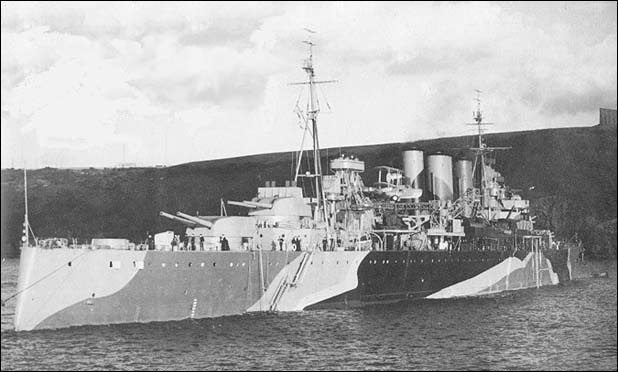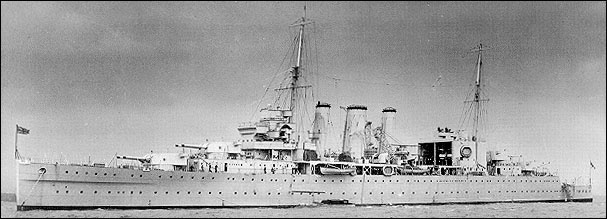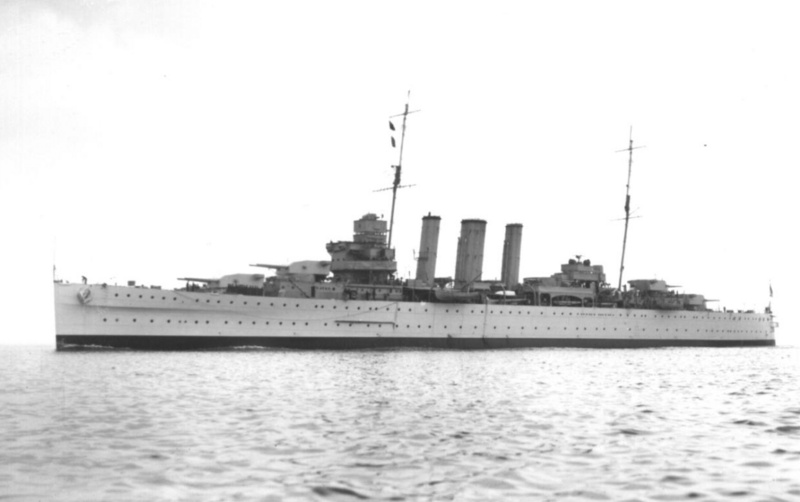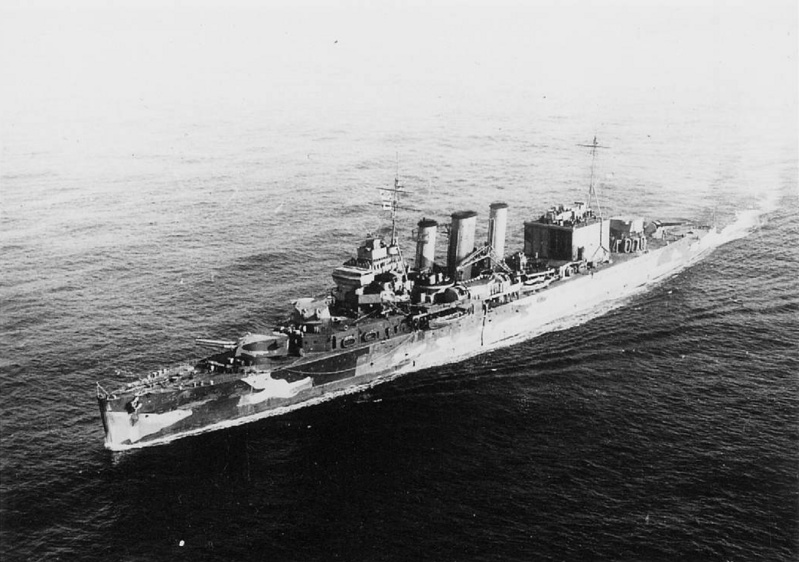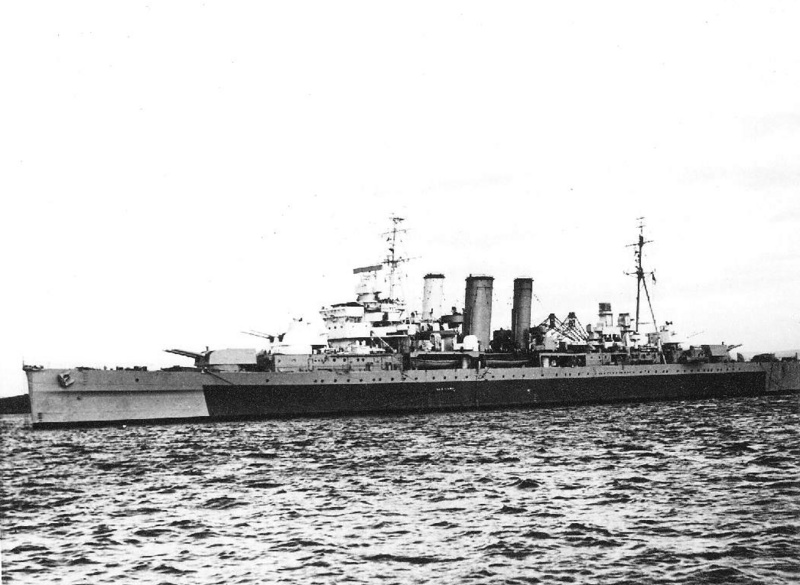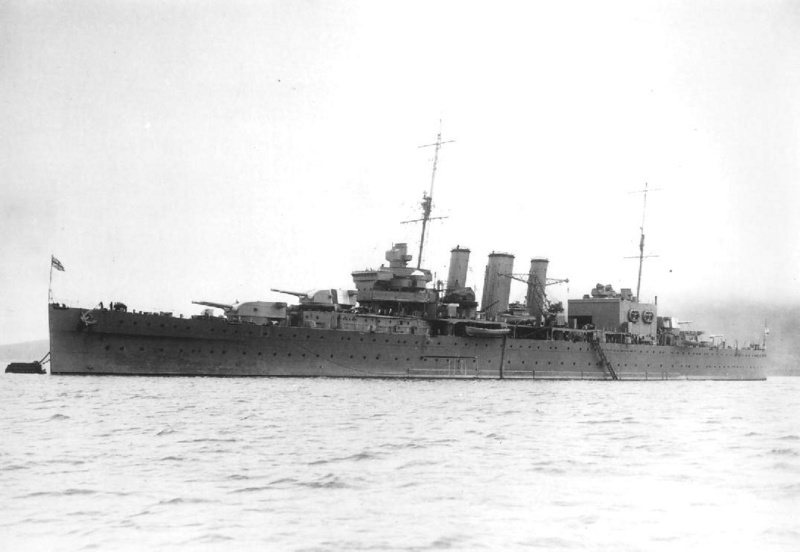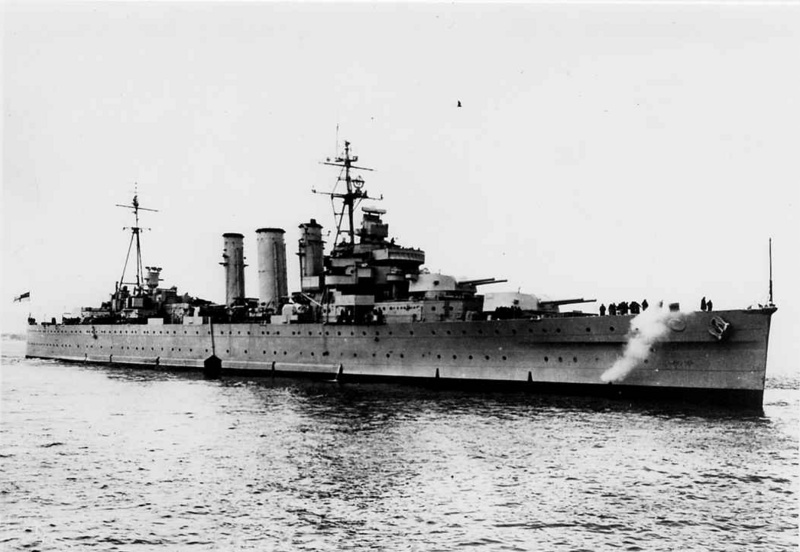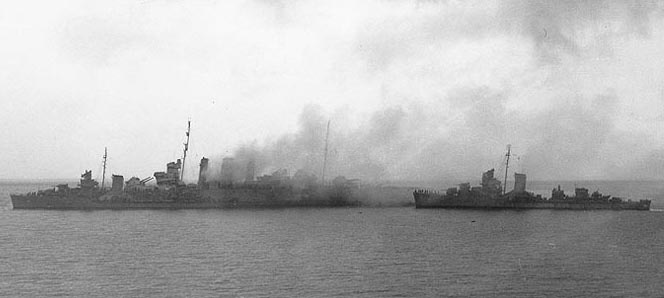Introduction
The vessels of the Kent class were constructed in the late 20s to compensate for the lack of warships in the Pacific and the Chinese Sea. As the Admiralty paid no attention to the threat from the air, only a little anti-aircraft defense was installed. This was a severe shortcoming as in the end, out of these seven vessels, two were sunk by Japanese aircraft. Halfway through the 30s, it was decided to equip them with additional AA artillery but this proved insufficient. This didn't mean they didn't prove to be valuable vessels during World War Two. Although they were already outdated at the time, both the British and Australians put these ships to good use.
Technical data
| Land: | England |
| Class: | Kent |
| Model: | 8" cruiser |
| Type: | Heavy cruiser |
| Number in class: | 7 |
| Crew: | 679 normal; 710 as flag ship |
| Max speed: | 31.5 knots |
| Weight: | 9,750, 13,238 BRT loaded |
| Armament: | eight 4" cannon in four turrets; four 2 pound AA guns, eight .50 twin barrel machineguns, sixteen 21" torpedo tubes |
| Power plant: | two Parsons geared or two Brown Curtis steam turbines, eight boilers, two screws |
| Displacement: | 16,400 BRT |
The Kent class – a subclass of the County class cruisers – consisted of seven vessels: HMS Cumberland, Kent, Suffolk, Berwick, Cornwall and HMAS Australia and HMAS Canberra
Definitielijst
- cannon
- Also known as gun. Often used to indicate different types of artillery.
- torpedo
- A weapon of war. A cigar shaped body fitted with explosives and a propulsion and control mechanism. Intended to target after launch a nearby enemy ship and disable it by underwater explosion.
HMS Cumberland
The keel of this vessel was laid on October 18, 1924. She was built on the Vickers shipyard in Barrow and construction was completed on December 8, 1927.
After having been commissioned, she was dispatched to China right away. She was upgraded the same year. Until early 1939, she was allocated to the 2nd Cruiser Squadron. When the German battleship Admiral Graf Spee was active in the southern Atlantic, the Admiralty decided to transfer her to the South-American division. Here she played a minor role in the sinking of the Admiral Graf Spee. When this vessel was intercepted, she could not take part in the naval battle because her turbines urgently needed maintenance. Until July 1939, she also was the flag ship of Admiral Harwood. Thereafter, his flag was transferred to the light cruiser HMS Ajax for tactical reasons.
In June 1940, HMS Cumberland escorted the first convoy carrying troops across the Atlantic. Subsequently, she participated in Operation Menace, an operation aimed at restraining the Vichy Fleet. She also took part in the bombing of the Moroccan city of Casablanca, an important Vichy port. During the first week of September 1940, various French vessels were damaged during this operation.
On September 16, 1940, she sank the ammunition vessel Poitiers, a Vichy-French ship. She was also involved in an action off Dakar in French West-Africa (today Senegal). The port was severely damaged and various ships were either sunk or damaged. In 1941, she was sent back to the Home Fleet.
Between November 1941 and January 1944 she escorted convoys to Murmansk and afterwards she was sent to the Pacific. She was involved in the raid on Sabang and participated in the recapture of the island of Sumatra (Dutch East-Indies) and the Nicobar islands which belonged to the British-Indies.
In 1945, she was also involved in the surrender of Birma (today Myanmar). She was repaired in the Dutch East-Indies and afterwards spent her last years in British home waters. She was mothballed in November 1946.
As late as 1951, the vessel took part in testing a new anti-aircraft system. She was the only cruiser taking part in these tests. After HMS Cumberland had been taken out of service, the former navy leadership remarked: 'That old hag is finally decommissioned". In 1956, the ship was used in the movie "The battle of the river Plate,"
On November 3, 1959, the vessel was dismantled on the Cashmore yard in Newport.
Definitielijst
- battleship
- Heavily armoured warship with very heavy artillery.
- division
- Military unit, usually consisting of one upto four regiments and usually making up a corps. In theory a division consists of 10,000 to 20,000 men.
- raid
- Fast military raid in enemy territory
- Squadron
- A military unit in the Belgian navy usually six to eight small ships operating together under one command. The smallest military unit in the Dutch air force of about 350 men. In most countries is the designation of a military unit thesize of a company. It is either an independent unit, such as a battery, or part of a bigger Calvary unit. In the air force it is the designation of a unit of aircrafts.
HMS Kent
HMS Kent was constructed on the Chatham Dockyard in Portsmouth and launched on November 15, 1924.
After having been commissioned, she was dispatched to China right away, just like HMS Cumberland She served in the 5th Cruiser Squadron in Hong Kong. She remained there until; 1937 when she was sent back to England to be upgraded. This lasted until early 1938.
After her upgrade, she was sent to the Pacific. Being part of the 4th Cruiser Squadron, she was tasked with hunting down raiders, converted neutral merchantmen attempting to attack freighters sailing individually. Shortly after she was deployed escorting convoys carrying troops.
In the summer of 1940, she was dispatched to the Mediterranean to join the 3rd Cruiser Squadron. After the bombing of Bardia in North-Africa, she attacked the port of Benghazi but in the night of September 17 to 18, she was struck by a torpedo from an Italian aircraft. She was towed to Alexandria but couldn't be fully repaired there. Therefore she was sent to England for extensive repairs. She was in dock until September 1941.
From that moment on, she was part of the Home Fleet. She escorted convoys to Murmansk and launched attacks on the Norwegian coast. She was also involved in numerous attacks on the Tirpitz. She was mothballed in January 1945, decommissioned on January 22, 1948 and dismantled on January 31, 1948.
Definitielijst
- Squadron
- A military unit in the Belgian navy usually six to eight small ships operating together under one command. The smallest military unit in the Dutch air force of about 350 men. In most countries is the designation of a military unit thesize of a company. It is either an independent unit, such as a battery, or part of a bigger Calvary unit. In the air force it is the designation of a unit of aircrafts.
- torpedo
- A weapon of war. A cigar shaped body fitted with explosives and a propulsion and control mechanism. Intended to target after launch a nearby enemy ship and disable it by underwater explosion.
HMS Suffolk
HMS Suffolk was constructed on the Chatham Dockyard and – like HMS Kent - right after launch, she was dispatched to China. In 1939, with World War Two looming, she was recalled to England where she arrived in October. Together with the other heavy cruiser, HMS Norfolk, she patrolled the strait between Iceland and Greenland.
In April 1940, she supported the Norwegian campaign and on October 17, she was hit by fire from a battery near Stavanger and towed to Scapa Flow. She was being repaired until February 1941. When these were completed, she and HMS Norfolk returned to their former station.
When in March 1941, Bismarck attempted to break out into the Atlantic she and HMS Norfolk shadowed the German vessel during the entire sea battle. She even launched a torpedo against the enemy vessel without success though. From 1942 onwards, she escorted convoys to Murmansk and cruised in the north Atlantic.
In April 1943, she returned to the Far East, taking part in the capture of various islands in the Pacific and in the Dutch East-Indies. She was mothballed in May 1946, decommissioned on March 25, 1948 and dismantled on June 24, 1948.
Definitielijst
- torpedo
- A weapon of war. A cigar shaped body fitted with explosives and a propulsion and control mechanism. Intended to target after launch a nearby enemy ship and disable it by underwater explosion.
HMS Berwick
This vessel was constructed by the Fairfield Shipbuilding & Engineering Co in Bovan and launched on September 15, 1924.
After having been stationed in China for a while, she was transferred to the Mediterranean. In 1938 she was taken out of service in order to be upgraded. This lasted until 1938. Thereafter she was sent to America to serve on the West-Indian station until 1939 as part of the 8th Cruiser Squadron.
From September 1939 on, she and the other heavy cruiser HMS York she went searching for raiders as part of Force F. She didn't meet any raider but she did sink the blockade runners Wolfsburg and Uruguay in March 1940.
In April 1940, she participated in the Norwegian campaign after which she served in the Home Fleet for a short time. On November 7, 1940, she was sent to Force H in Gibraltar in order to take part in the attack on the Italian naval base Taranto. She also escorted convoys carrying troops to Greece. On November 24, 1940, she was ordered to set sail for Freetown, along with other vessels including the carrier HMS Formidable in order to sink the German battlecruiser Admiral Scheer. A few days later, this order was revoked and the cruiser was sent into the north-Atlantic to escort convoys.
On December 25, 1940, while escorting convoy WS.5a, she was engaged in battle with the German heavy cruiser Admiral Hipper. The British vessel was severely damaged in this encounter and had to return to Great Britain for repairs. This lasted until June 1941.
When repair was finished, she was allocated to the Home Fleet again. In February 1942 she participated in attacks on the German battleship Tirpitz. During the remainder of the war, she escorted convoys to Murmansk and didn't take part anymore in major actions. She did however escort carriers in 1944 and 1945 in renewed Allied attempts to sink the Tirpitz.
She was decommissioned on June 15, 1948 and dismantling began on July 12, 1948.
Definitielijst
- battleship
- Heavily armoured warship with very heavy artillery.
- Squadron
- A military unit in the Belgian navy usually six to eight small ships operating together under one command. The smallest military unit in the Dutch air force of about 350 men. In most countries is the designation of a military unit thesize of a company. It is either an independent unit, such as a battery, or part of a bigger Calvary unit. In the air force it is the designation of a unit of aircrafts.
HMS Cornwall
This vessel was constructed at the Devonport dockyard in Plymouth. Her keel was laid on October 9, 1924 and she was launched on March 11, 1926.
After commissioning, she was sent to China. Like the other vessels of the Kent class, she was recalled to England to be upgraded. She returned to the 5th Cruiser Squadron in 1938. Based on Ceylon (today Sri Lanka) she patrolled the Pacific hunting down enemy raiders. She was also involved in the hunt for the Admiral Graf Spee when this ship was cruising in the Pacific. She managed to chase the enemy vessel out of these waters.
Early 1940, HMS Cornwall was sent to Freetown in West Africa where she took part in the bombing of Dakar in August 1940 and other actions. Thereafter she was sent back to the Pacific in order to intercept enemy raiders. On May 5, 1941, she managed to sink the raider Pinguin. Apart from 300 Germans, 200 PoWs lost their lives as well. She did manage to rescue some 60 crew members and 22 prisoners though.
After this action, she was sent back to India from where she escorted troop carrying convoys. On April 5, 142, HMS Cornwall was spotted by a Japanese scout plane from a fleet consisting of among others, the cruiser Tone. Numerous Japanese bombers took to the air and plastered the British vessel. The cruiser sank in a short time, due to nine direct hits. HMS Dorsetshire was sunk as well. Most of the crew members were rescued by the light cruiser Enterprise, the destroyer Paladin and HMS Panther.
Definitielijst
- destroyer
- Very light, fast and agile warship, intended to destroy large enemy ships by surprise attack and eliminating them by using torpedoes.
- Squadron
- A military unit in the Belgian navy usually six to eight small ships operating together under one command. The smallest military unit in the Dutch air force of about 350 men. In most countries is the designation of a military unit thesize of a company. It is either an independent unit, such as a battery, or part of a bigger Calvary unit. In the air force it is the designation of a unit of aircrafts.
HMAS Australia
This vessel and HMAS Canberra were both constructed on the John Brown yard in Clydebank for the Royal Australian Navy. She served in Australian waters. She was upgraded in 1938 and was operational just before the outbreak of World War Two. During her upgrade, she was fitted with additional AA armament and a device to launch aircraft.
After war had broken out, she carried out anti-raider patrols in the Pacific and the southern Atlantic. In the mid-40s she took part in the bombing of Dakar, a port controlled by Vichy-France. She damaged the French cruiser l'Audacieux in such a way that it ran aground. HMS Australia was damaged herself in the process and had to return to Australia for repairs. She was in dry dock until early 1941. After repairs, she resumed anti-raider patrols and escorted convoys in the Atlantic and the Pacific.
In 1942, a small flotilla was formed to protect the southern Pacific and the area east of Australia. She was made the flag ship. In May 1942, she took part in the Battle of the Coral Sea, providing protection against aircraft. In August she protected the landing ships that were to recapture Guadalcanal after which she took part in the cleansing of New Guinea. She bombed the coast prior to the landings. Later on, she did the same during the recapture of New Britain.
June 8, 1944, she was made the flag ship of a small flotilla that was to clear the waters north of New Guinea of Japanese destroyers. This lasted until October 1944. During the Battle of Leyte Gulf, she was hit by the first kamikaze attack. The Japanese aircraft carried a 440lbs bomb which could have destroyed her. Fortunately, the bomb didn't explode. Nonetheless, 30 crew members lost their lives and she was severely damaged. On October 25, just a few days after the kamikaze attack the cruiser was hit again, forcing her to return to the New Hebrides for repairs.
In January 1945 she took part in the battle in the Gulf of Lingayen. Towards the end of the war, she had been subjected to no less than six kamikaze attacks, claiming the lives of over 80 crew members.
After the war, the cruiser was almost completely stripped of her armament and served as a training vessel. She was mothballed in August 1945 and dismantled in January 1955.
Definitielijst
- Guadalcanal
- First island in the Pacific liberated by US forces from the Japanese during World War 2. Between August 1942 and February 1943 a number of confrontations on land, at sea and in the air took place on this island.
- kamikaze
- “Divine Wind”. A kamikaze pilot would fly himself, his airplane and bomb(s) literally into an enemy target, preferably a US ships. This was a noble cause, considered a most honourable death for the emperor. Several thousands of kamikaze pilots died this way.
- mid
- Military intelligence service.
HMS Canberra
Construction of this vessel was completed on March 24, 1928. She was sent to Australia in September 1931 where she made voyages to New Caledonia and Fiji. From 1936 until 1938, she even was the flag ship of a cruiser squadron. She visited the British China station in 1932 and once again in 1937.
At the outbreak of war, she escorted convoys through the Tasmanian Sea. In June 1940, she was sent to the Pacific in support of the British Navy. Here she escorted convoys from Freemantle to Colombo and Cape Town. In July of that year, she chased the German raider Atlantis from Africa to India and from there to the Maldives. The German raider managed to escape though. In November 1940, she pursued the German raider Pinguin but did not catch this one either. Early 1941 she returned to the Pacific. Here again, she hunted down German and Japanese raiders. Because this was in vain as well, she took part in the hunt for the Admiral Scheer. In mid-June she was sent to the eastern Pacific for patrol duties.
In the last week of June 1941, she returned to Australia. After the Japanese attack on Pearl Harbor, she escorted convoys from Australia to New Guinea. February 7, 1942, she was sent to Melbourne and later to Sydney. In the night of February 28 to March 1 she managed to sink a Japanese submarine. As part of the American Flotilla Task 44, she took part in the Battle of the Coral Sea. In August 1942, she supported American landings on Guadalcanal and Tulagi. Right after the start of the battle of the island of Savo, she was struck by two torpedoes and 20 direct hits of 203mm guns. Almost 200 crew members perished, along with their captain Frank E. Getting.
Definitielijst
- Guadalcanal
- First island in the Pacific liberated by US forces from the Japanese during World War 2. Between August 1942 and February 1943 a number of confrontations on land, at sea and in the air took place on this island.
- mid
- Military intelligence service.
- squadron
- A military unit in the Belgian navy usually six to eight small ships operating together under one command. The smallest military unit in the Dutch air force of about 350 men. In most countries is the designation of a military unit thesize of a company. It is either an independent unit, such as a battery, or part of a bigger Calvary unit. In the air force it is the designation of a unit of aircrafts.
Information
- Article by:
- Michiel Stinckens
- Translated by:
- Arnold Palthe
- Published on:
- 25-12-2023
- Feedback?
- Send it!
Sources
POWELL, M., De ondergang van de Graf Spee, Utrecht / Antwerpen, 1962.
